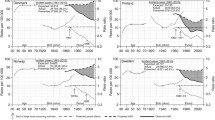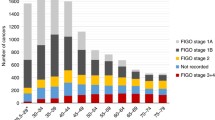Abstract
Data from the screening programme in British Columbia are used to test hypotheses about the natural history of cervical cancer, especially about progression and regression of preclinical lesions (dysplasia and carcinoma in situ). Three models are considered. A model without regression does not give an adequate fit of the data (P less than 0.001), and results in an implausible estimate of 33 years for the mean duration of pre-invasive lesions. A model with an equal regression rate at all ages still does not result in a good reproduction of the data. A good fit is achieved for a model with different regression rates in lesions that develop under and over age 34. Under age 34, 84% of the new lesions will regress spontaneously, with a 95% confidence interval of 76-92% regression. Over age 34, we estimate that 40% of the new lesions will regress. The average duration of dysplasia + CIS is 11.8 years, and the sensitivity of the Pap-smear is 80%. It is concluded that a considerable proportion of pre-invasive lesions in young women do not progress. The findings about progression and duration of pre-invasive lesions do not support the still prevailing tendency of frequently making Pap smears in young women.
Similar content being viewed by others
Author information
Authors and Affiliations
Rights and permissions
About this article
Cite this article
van Oortmarssen, G., Habbema, J. Epidemiological evidence for age-dependent regression of pre-invasive cervical cancer. Br J Cancer 64, 559–565 (1991). https://doi.org/10.1038/bjc.1991.350
Issue Date:
DOI: https://doi.org/10.1038/bjc.1991.350
- Springer Nature Limited
This article is cited by
-
Can the prophylactic quadrivalent HPV vaccine be used as a therapeutic agent in women with CIN? A randomized trial
BMC Public Health (2020)
-
16/18 genotyping in triage of persistent human papillomavirus infections with negative cytology in the English cervical screening pilot
British Journal of Cancer (2019)
-
Reply to the Editor Regarding: Miranda RN, Clemens MW Letter to the Editor 2018 Apr 6 in Relation to: Fleming D, Stone J, Tansley P. Spontaneous Regression and Resolution of Breast Implant-Associated Anaplastic Large Cell Lymphoma: Implications for Research, Diagnosis and Clinical Management. Aesth Plast Surg, 2018
Aesthetic Plastic Surgery (2018)
-
Analysis of cancer genomes reveals basic features of human aging and its role in cancer development
Nature Communications (2016)
-
Cervical histology after routine ThinPrep or SurePath liquid-based cytology and computer-assisted reading in Denmark
British Journal of Cancer (2015)




